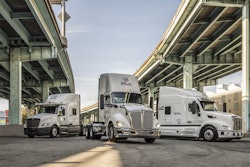
The global pandemic has paused or inhibited momentum for a number of industries, but not the trucking industry.
The economy relies heavily on drivers and fleets. Although it faces various obstacles — including increased demand and fewer drivers to meet it – the trucking industry continues to see significant growth.
According to the American Trucking Association, the trucking industry was short roughly 60,800 drivers back in 2018, and the shortage has continued. Experts estimate 80,000 fewer available drivers on the roads in 2021 vs. a year ago. A combined higher demand and lack of qualified drivers requires fleets to accelerate their digital transformation efforts to keep pace.
More fleets than ever before are leveraging cloud-based software and data to decrease planning time and optimize workflows. Fleet management software platforms enable fleets to do more with less and increase driver efficiency, which helps drivers complete more stops and thrive in a supportive work environment.
What specific capabilities have fleets invested in to rise above the competition, improve decision-making and meet demand?
Route optimization technology
AI-driven capabilities have catapulted route planning optimization technology forward. While AI will drive the future of trucking, it’s also driving the present with optimization technology.
This technology automates driver plans to set both fleets and drivers up for success. By taking data and constantly-changing variables like weather and construction into account, planners can assign drivers to routes that save time and reduce missed deliveries. AI has raised the industry standard for efficient route planning, and trucking has recognized the value of automated route optimization technology. Automation capabilities will continue to evolve and advance transportation management processes.
Drivers, as well as fleets, benefit from route optimization. AI-based software will increasingly enhance the driver experience by more effectively utilizing their skillsets.
Eventually, route optimization software will start taking additional driver variables into account, such as their experience levels and preferences. For instance, fleets could create smoother, more efficient dispatching and driver training processes by automatically assigning new drivers to easier routes.
Driver workflow software
The buzz around “workflow” is well-deserved these days. Drivers can use trip and location-enabled apps to access the digital forms they need for each stop and customer, saving time by reducing paperwork and bypassing unnecessary steps that, in the past, had caused manual-based errors.
Driver workflow solutions increase fleet flexibility.
With more advanced driver workflow software, each trucking company can customize their workflow steps and forms for drivers to suit their specific needs. These flexible forms and workflows improve the overall driver experience, which could lead to increased driver retention in the midst of a serious shortage. These solutions also boost productivity for all users: managers, dispatchers, planners, and drivers alike.
Driver workflow solutions also streamline communication.
Managers and drivers who use workflow software can communicate more easily via real-time data visibility, constant ETA updates and in-app messaging tools. Enhanced communication ensures operational efficiency and data integrity – critical for fleet managers and planners.
Driver workflow solutions streamline onboarding.
With fleets trying to meet constant demand, they’re always seeking ways to streamline the driver hiring and training process. Driver workflow technology eliminates those tedious, lengthy processes by reducing training time. A more intuitive dashboard means that drivers spend less time learning how to use and become comfortable with the software. Fleets benefit by saving money, time, and resources.
Trucking industry will benefit from embracing digital transformation
Managers and executives working to meet demand, increase efficiency and hire, train, and retain drivers need reliable fleet optimization solutions. In the midst of a pandemic and driver shortage, fleets that utilize route and workflow optimization technology can accomplish more with less. These digital transformation efforts use data and AI to improve decision-making and enable fleets to rise above the competition.
The future of transportation management has arrived; those who choose to ignore the technology will find themselves left far behind.











